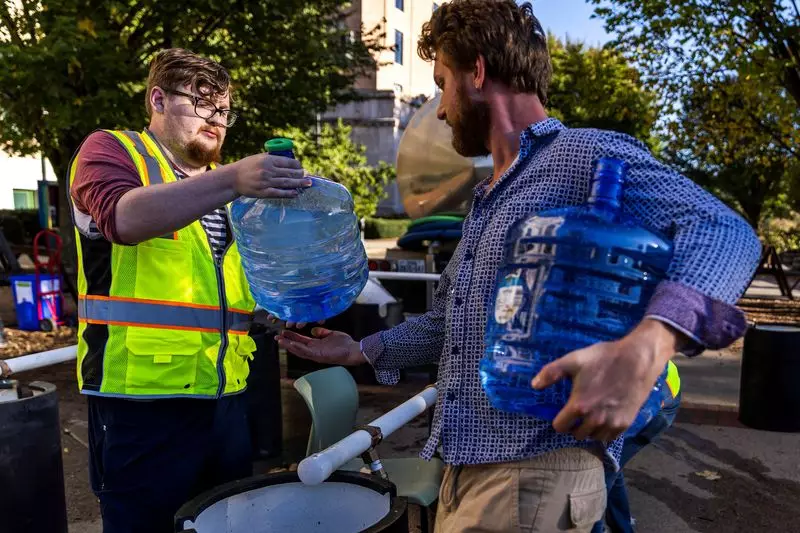In the wake of Hurricane Helene’s destruction—an unforgiving cyclone that wreaked havoc across the Southeastern United States—North Carolina finds itself grappling with a dire water crisis. As the storm made landfall in Florida as a strong Category 4 hurricane, its unrelenting rains and powerful winds caused catastrophic flooding that devastated infrastructure across the region. With reports indicating that over 180 lives were lost due to the storm’s wrath, the focus now shifts to the surviving residents of North Carolina, many of whom remain without access to potable water, six days after the hurricane’s passage.
The state is struggling to restore water services for tens of thousands of residents. According to state databases, around one-fifth of the population in the western region of North Carolina is either completely without water or facing severely reduced water pressure. In Asheville—one of the hardest-hit areas—more than 150,000 individuals rely on a municipal water supply system that has suffered extensive damage. It is a grim reality that underscored the vulnerability of essential infrastructure in the face of natural disasters. Without water, residents can’t perform basic hygiene practices or even flush toilets—a combination that pushes the situation into a public health crisis.
**Every Drop Counts**
The local response to this urgent need has been commendable yet chaotic. Initiatives to distribute clean drinking water have been established at various locations, with residents relying on community support to access basic necessities. Volunteers have mobilized to provide assistance, offering ready-to-eat meals and bottled water to displaced individuals who lack the means to retrieve supplies. Efforts by community members like David Shoham highlight the collective resolve to survive amidst adversity, as he and others await promised assistance with a mix of hope and frustration.
As rescue teams work diligently to restore services, key water plants face unprecedented challenges due to flooding that destroyed both primary and backup water systems. The North Fork water treatment plant, vital for supply, suffered significant damage, while neighboring facilities remain inaccessible due to debris. These setbacks reveal the complexities and logistical hurdles faced during disaster recovery—especially in remote areas that often rely on smaller water systems or private wells.
**A Patchwork Solution**
Residents in different North Carolina regions source their water from diverse supply lines, leading to complications in effective service restoration. The availability and reliability of local water systems vary dramatically: some depend on large municipal plants, while others rely on smaller neighborhood wells. The inconsistency in supply exacerbates the crisis, as the restoration timeline becomes uncertain and localized strategies falter.
Even amidst despair, community resilience shines through. Local businesses, schools, and hospitals are grappling with significant operational challenges, but solidarity has emerged. Actions by restaurant owners like Jordan Lance from Buxton Chicken Palace illustrate the spirit of community, as they prepare meals and gather supplies for those impacted. This sense of unity offers a glimmer of hope, fostering connections as neighbors assist those in need.
**Governmental Involvement**
Federal and state officials have been actively involved in the recovery efforts, with President Joe Biden visiting affected areas to assess damage and provide support. The presence of the National Guard and Federal Emergency Management Agency (FEMA) personnel offers reassurance to local residents while implementing plans for water distribution and infrastructure repair. Despite these efforts, local leaders, like Asheville City Schools Superintendent Maggie Fehrman, express concerns about the prolonged absence of water and its effects on daily life, particularly in schools and communities.
As North Carolina ruminates over the aftermath of Hurricane Helene, the path forward remains fraught with uncertainty and challenges. Restoring water services will likely take significant time and resources, with some estimates suggesting repairs could take weeks or even longer. Residents must navigate daily life in difficult conditions, leaning on community support while waiting for the state’s infrastructures to mend.
**Conclusion: A Call for Support and Preparedness**
The situation in North Carolina serves as a stark reminder of the need for adequate disaster preparedness and robust infrastructures that can withstand the force of Mother Nature. It compels us to rethink how communities think about water supply systems and emergency response strategies. Ultimately, the road to recovery will require not just the restoration of services but a renewed commitment to resilience and solidarity in the face of adversity as residents reflect on their experiences long after the waters recede.

